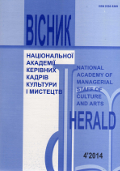ОСОБЛИВОСТІ МЕХАНІЗМІВ І ПРОЦЕСІВ ВІДТВОРЕННЯ КУЛЬТУРИ ПРАВОСЛАВНОГО ЧЕРНЕЦТВА
The features of the mechanisms and processes of reproduction of the Orthodox monasticism culture
Author(s): Olga Olegivna SmolinaSubject(s): Anthropology, Ethics / Practical Philosophy, Eastern Orthodoxy
Published by: Національна академія керівних кадрів культури і мистецтв
Keywords: the culture of the Orthodox monasticism; reproduction of culture; the monastic culture; the monastery culture;
Summary/Abstract: We think that the Orthodox monasticism culture where formed a special picture of the world and the ways of a man's relationship with the world, God and nature, must have a certain specificity of the processes of its reproduction and translation. In the literature devoted to studies of religious phenomena such as the culture of monasticism, the ways and means of its transmission are considered only in fragments. However, it is known that the Orthodox monasticism culture divides into two types. They are a "monastic culture" (a contemplative monastic direction) and a "monastery culture" (its active direction). That’s why we get a problem of studying the mechanisms of reproduction and transmission of the culture of Orthodox monasticism in each types of the cultures. This is the goal of this article. The relevance of studying this issue is connected with the modern process of the religion revival in the postsoviet space and the increasing of its influence in the culture. The culture of monasticism is characterized as one of the most conservative and highly normalized structures of the church. The main source of monastic rules is the Gospel. The Gospel contains the instructions basing monastic maxims (self-denial, obedience, chastity). The a novice or a monk obedience before the spiritual guide for the more experienced elder monk is necessary for the more effective realization of monastic asceticism. The instructions of the most respected monks are the Holy tradition, which is the source of rules in the Orthodox Church with the Gospel.The ability to change the rules of monastic life is dependent on the type of culture of Orthodox monasticism. In the monastic culture the rules are constant. This is the culture that creates the understanding of the conservative character of the Orthodox monasticism culture. At the same time, the rules take into account the personal characteristics of the individual and his/her work suggests some creativity in the embodiment of that rule. The monastery culture focuses on the interactions with the society, the rule is a subject which changes under the influence of political, national, economic and others factors. Such changes may concern the forms and methods of the monk social work, the art in the monastery, the clothes of monks and etc.It is known that the standards will be implemented in the activities if there are people who can recreate the structure or operations according to these standards. It is possible to notice that the reproduction of the monasticism culture by the people of the past centuries (before the XIX – the beginning of the XX centuries) were entirely organic, as the culture was full of Christian influence. Nowadays there are huge gaps between the values and ideological basis, the conceptual world of the secular culture and the monasticism culture.We are not taught how to be a monk. The elements of the monasticism culture are "spilled" into the culture of the Church, Christian culture. Despite of the importance of the mechanisms of reproduction and translation in any culture, the ability to be a monk in the culture of Orthodox monasticism is regarded not as a result of training, but as the originally given (since childhood) predisposition of the individual.The asceticism does not deny the existence of the communication channels with the world. The calling of a monk is not only a personal salvation, but also in promoting the salvation of the world through "a prayer as an activity" or "activities like a prayer." The monastic culture has a few channels of communication with the world such as a personal conversation with an old man, the theological and ascetic literature and a worship. The monastery culture uses also such channels as the architectural complex of the monastery, a network of social institutions, the media, the systems of farmsteads, the pilgrimage, etc.However, the monasticism culture is not the sender but a repeater of meanings and promises, recorded in the Gospel. It is designed not to generate reports but to embody them, to indicate their applicability in human life, to interpret according to the changes outside of the monastery walls.The feedback factor (the response of the world) is less important for the monastic culture than the culture of the monastery. The monastery culture can change a form of feed posts (architectural, iconic style, the language of the messages, find a new translation, and etc.), but not its meaning. In general, the feedback plays a smaller role in the culture of Orthodox monasticism than in the secular culture.In the modern society because of its predominantly secular character the recipients of information which is transmitted by the culture of Orthodox monasticism, do not always have the appropriate code for its adequate perception and understanding.
Journal: Вісник Національної академії керівних кадрів культури і мистецтв
- Issue Year: 2014
- Issue No: 4
- Page Range: 38-42
- Page Count: 5
- Language: Ukrainian

